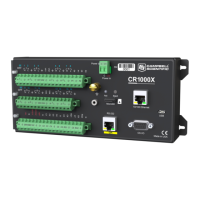5. Data memory
The datalogger includes three types of memory: SRAM, Flash, and Serial Flash. A memory card
slot is also available for an optional microSD card. Note that the datalogger USB port does not
support USB flash or thumb drives (see Communications ports (p. 12) for more information).
5.1 Memory allocation
Data table SRAM and the CPU drive are automatically partitioned by the datalogger. The USR
drive can be partitioned as needed. The CRD drive is automatically partitioned when a memory
card is installed.
The CPU and USR drives use the FAT file system. There is no limit, beyond practicality and
available memory, to the number of files that can be stored. While a FAT file system is subject to
fragmentation, performance degradation is not likely to be noticed since the drive has a relatively
small amount of solid state RAM and is accessed very quickly.
5.2 SRAM
SRAM holds program variables, communications buffers, final-data memory, and, if allocated,
the USR drive. An internal lithium battery retains this memory when primary power is removed.
The structure of the datalogger SRAMmemory is as follows:
l Static Memory: This is memory used by the operating system, regardless of the running
program. This sector is rebuilt at power-up, program recompile, and watchdog events.
l
Operating Settings and Properties: Also known as the "Keep" memory, this memory is used
to store settings such as PakBus address, station name, beacon intervals, and allowed
neighbour lists. This memory also stores dynamic properties such as known routes and
communications timeouts.
l CRBasic Program Operating Memory: This memory stores the currently compiled and
running user program. This sector is rebuilt on power-up, recompile, and watchdog events.
l Variables & Constants: This memory stores constants and public variables used by the
CRBasic program. Variables may persist through power-up, recompile, and watchdog
events if the PreserveVariables instruction is in the running program.
l Final-Data Memory: This memory stores data. Auto-allocated tables fill whatever memory
remains after all other demands are satisfied. A compile error occurs if insufficient memory
5. Data memory 38

